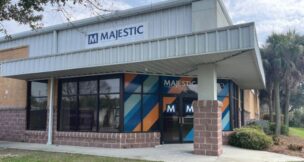Prysmian Group playing big role in connecting the future
Melinda Waldrop //January 15, 2018//
Mike Adams remembers a very different time at Prysmian Group.
Adams, plant manager at the global cable manufacturer and energy solution company’s North American headquarters in Lexington, has worked for Prysmian for 26 years. That includes a stretch in the late 1990s when the telecom bubble burst, as drastic downturn and massive layoffs followed unsustainably rapid growth.
“That is something you never want to go through,” Adams said. “You’re laying whole rooms of people off. We shut two or three factories down. All of telecom did.”

The company and the industry have come full circle from those dark days. Prysmian Group, which has poured $15 million into its Lexington headquarters as part of a $289 million worldwide expansion plan, announced the acquisition of General Cable Corp. in December, and is partnering with Verizon to support the telecom provider’s development of its 5G services.
Prysmian, which sank an additional $14 million into its Abbeville plant last July, also plans to open a global research and development facility in Lexington next month.
It’s a much better place for Adams, who noted Prysmian hired back many of the laid-off workers, and he is more confident in the staying power of this upswing.
“The good thing about this one is, even though it’s growing and it’s growing fast, it’s not growing bubblish,” he said. “All the mechanics underneath it sustains it. Everybody wants more cell phones, more bandwidth, more cable, faster options, on demand.”
Hakan Ozmen, CEO of Prysmian Group North America, agrees with that assessment. Ozmen said both the international market and its major players are better prepared for fluctuations. Prysmian in particular, buoyed by an acquisition spree in the 1990s, is diversified enough to insulate it from great risk, he said.
“We are very diversified in terms of distribution of our presence in the market versus risk and market turmoil,” Ozmen said. “Apart from that, we are also in multiple currencies, and we are balanced with the other currencies.”
Prysmian’s acquisition of General Cable at $30 per share in cash is expected to close in the third quarter. The transaction, which will increase Prysmian’s North American presence, values General Cable at approximately $3 billion. Prysmian’s three-year contract with Verizon is worth approximately $300 million and will speed development of Verizon’s 5G services while also improving 4G LTE and other broadband capacity.
“The market is moving very fast in the telecom industry,” Ozmen said. “Every device is now connected to or is being promoted to being connected into the internet, to be controlled via internet, via wi-fi, and for all this, you need 5G. You need 5G also for the smart cars which have no drivers. All this will need an infrastructure, and this is what Verizon is doing as they prepare for the users and the service providers.
“We are trying to find solutions together with the service providers like Verizon to create that platform so that new applications and new possibilities to connect the world are going to be possible.”
A history of connections
Prysmian has been providing connections since 1900, when transatlantic telegraph and submarine cables were big businesses. After going public in 2010, Prysmian merged with cable manufacturer Draka in 2011 to create the Prysmian Group, a multinational corporation headquartered in Milan, Italy.
“Without cables, you can’t do anything,” Ozmen said. “The best cable, you never see. You bury it or you hide it, and it functions forever. It goes everywhere. It goes from connecting islands to connecting cities and connecting people with photo devices. When we talk about wireless, you can’t have wireless without wires. You have to have cables. You have to have the stations which help the devices to be connected.”
Adams is passionate about those cables. He led a tour of the Prysmian plant with enthusiasm bundled as tightly as the ribbons of cables spinning through an array of machinery. He pointed out an improvement on the ribbon line, part of the $15 million investment, that he said has made the production process 40% more efficient.
Ozmen said the expansion will increase overall capacity at the Lexington plant by 30%.
The amount of fibers in a cable depend upon how much information needs to be transferred. With hundreds of fibers in each cable in some cases, the margin for error is razor-thin.
“We make essentially everything to order,” Adams said. “If it’s in stock, that means I screwed it up.”
The intricate production requires qualified workers, a need Prysmian tries to fill with several recruitment programs, including MBA programs in conjunction with the University of South Carolina and an initiative that sends recent graduates abroad to train for several years. Upon return, those employees are already on a management track.
“We see that South Carolina is an environment where investments are coming, but you have to be able to drive people into the area, and people with know-how,” Ozmen said. “We are attracting good engineers, but the pool could be improved further.”
Adams’ excitement about the constant technological advances that continue to push boundaries would serve as an effective recruiting tool.
“You think that you’re at the end of what people have figured out and want to do,” Adams said. “At the end of three months, something else will come. I just can’t imagine going into a cardboard factory and making the same cardboard box every day. This is way more dynamic.”
i
















